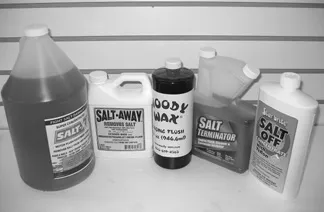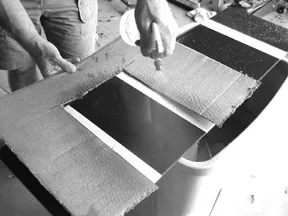To go that extra step in protecting your boat and engine from salt, consider these products. We tested five, and Salt-Away is our top pick.

Salt water. We sailors love the fact that it can lead us to so many inviting areas and experiences, but boy do we hate what it does to our boats and gear. Salt water can be the source of great frustration-and financial expense. As we all know, salt causes corrosion; therefore, we must get rid of it to protect the devices that allow us to take pleasure in the salty sea.
A freshwater washdown for the boat and a freshwater flush for outboard engines are recommended after each outing in salt water, but let’s face it-relatively few people manage to comply with those recommendations, and even if they do, their ministrations may not be enough to prevent corrosion in the long run. Some boat owners want extra protection, as evidenced by the growing use of “salt-eradicating” products like Salt-Away and Salt-X.
The function of these products is twofold: First, they claim to break down and remove salt from the cooling system of engines and leave behind a protective coating. Second, they can be used to remove salt from the exterior of a boat, engine,or trailer. We found five different manufacturers of these salt-fighting solutions, so we rounded up their products, and tested them.
What We Tested
There are two approaches to engine-flushing: permanently installed systems in the engine’s cooling apparatus, and portable units that attach to the engine’s external flush ports. The permanent units are meant for inboards and I/Os. The Guardian from Marine Science Technologies and Perkos Flush-Pro are two popular brands. The external units can be used on inboards, I/Os, and outboards. We tested the external flush systems only.
Our test group included five products from five different companies: Salt-X by Innovative Chemicals, Salt-Away, Salt Off from Starbrite, Salt Terminator from Kwik Tek, and Woody Wax’s engine flush.
All five products work basically the same way. They draw the anti-salt fluid from a container, mix it with water, and dispense the solution through the engine’s cooling system. There are differences in how these products accomplish this job, however, as we’ll see.
These products also can be used to remove salt from exterior surfaces. Woody Wax’s system utilizes two different liquids: an engine flush and a soap. The soap, even though it is not marketed as a salt-fighting cleaner, does contain salt-fighting elements, according to company owner Woody Cronin. His company will be selling an anti-salt cleaner for exterior surfaces in the near future, he told us.
The Woody Wax flush kit consists of a solid brass injector with three ends, four 2-oz. containers of engine flush fluid, two 2-oz. containers of boat soap, and a brass spray nozzle to be used with the boat soap. All components are packaged neatly in a plastic Plano box.
One end of the brass injector receives the garden hose. The container of flushing fluid is screwed to the second end. And the third end attaches to the flush port. Two small levers on the brass fixture control the flow of water and flushing fluid. You have to be careful not to use full water pressure or the bottle will crack or burst.
Salt-Away, Salt Off, and Salt Terminator are all sold in kits that consist of a quart of salt-cleaning solution and a mixing unit. You can also buy gallon jugs and small spray bottles of all three. Salt-Away can even be bought in 15-, 30-, or 55-gallon drums.
The mixers connect to a garden hose on one end and the engine flush port on the other. A removable cup that holds the salt-eradicating fluid is screwed into the mixing valve. A dial on top of the valve controls the flow of the fluid into the hose. The mixing units from Salt Off and Salt Terminator were identical, with a two-position dial: on and off. The unit from Salt-Away had a third position to allow a rinse with fresh water only.
The fifth product, Salt-X, does not use a mixing unit that attaches to the hose end. Instead, its “mixer” draws the anti-salt fluid through a clear plastic tube that’s inserted into a 1-gallon bottle of the fluid. (It also comes in a 22-oz. spray bottle, a quart container, a 5-gallon container, and a 55-gallon drum.) Salt-X does it this way to ensure a consistent draw of fluid from the container, and to avoid running out of fluid in the flushing process, which can happen with the hose-end types from Salt-Away, Salt Terminator, and Salt Off.
There is no means of controlling the water or fluid at end of the hose, however, which is a drawback in the convenience department.

How We Tested
We evaluated these products in three separate procedures. First, we wanted to find out how well they protected surfaces from corrosion. We mixed a solution of 90% salt water and 10% product and filled a small container with each mixture. We then placed identical nails in each container and let them sit in their respective containers for two days. Then we emptied half of the solution from each container, exposing the top portion of each nail to the air. Several days passed, and we noted the amount of corrosion on each nail.
We also wanted to rate the ease of use of each system. To do so, we took them down to the boatyard and flushed our 150-hp Mercury test engine with each product-and used them in their salt-removal function on the exterior of the boat and engine.
The final segment aimed to see how well the products removed salt from exterior surfaces. We sectioned off a sheet of Masonite covered with black high-gloss enamel, and used a spray bottle to apply salt water. We sprayed the panel as evenly as possible four times, letting the water dry in between sprays so that a visible coating of salt remained. Then, we applied each product-also using spray bottles.
Results
All five products removed all of the visible salt from their respective panel sections in our spray test.
In the corrosion test, the nail in the jar of Woody Wax and the nail in the jar of Salt-Away showed no rust or corrosion after a week of exposure to the air. Visible rust stains spotted the nails in the Salt-Off, Salt-X, and Salt Terminator jars.
All five products are relatively easy to use. The Salt-X, with its gallon of fluid, might be better suited for use in boatyard applications where a lot of fluid is likely to be needed. You’ll avoid having to refill the small hose-end containers of the others.
However, we prefer the hose-end mixing units. They’re just easier to deal with, and you don’t have to worry about tipping over a large container.
Among these types, the Woody Wax and the Salt-Away performed best in the corrosion test. So our decision comes down to these two. The Salt-Away kit, which is $35 for a quart with mixer, covers all the bases. Not only did it protect its nail in the corrosion test, its mixer was the easiest to use. In addition, the Salt-Away mixer was the only one with a “rinse only” function, which means you don’t have to detach it from the hose if you want to do some rinsing with fresh water only.
Our runner-up is Woody Wax. You get a lot for $30. The brass injector appears to be made to last, and the company backs it with a lifetime warranty. For those who are hard on their gear, the Woody Wax and its brass injector kit would be a good solution. It won’t crack if you drop it on the deck or run over it with the trailer.








